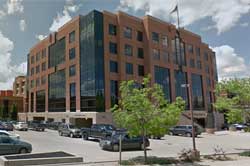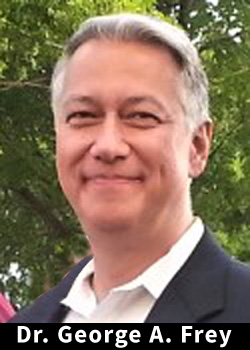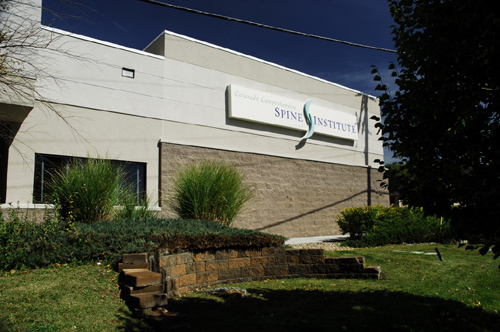Locations

Fax: (303) 762-9292

Adolescent Idiopathic Scoliosis
An Interview with Dr. George Frey
Question: What is Adolescent Idiopathic Scoliosis?
Dr. Frey
Adolescent Idiopathic Scoliosis (AIS) is a lateral (side) curvature of the spine that can occur in children aged 10 to maturity. The spine may curve to the left or right. Sometimes AIS may start at puberty or during an adolescent growth spurt.
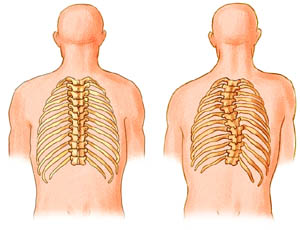
Idiopathic means the abnormal curve develops for unknown reasons. There is undoubtedly a genetic pre-disposition for some adolescents to develop AIS. Three to five percent of adolescents will be found to have some form of scoliosis. Most of these children will be girls, in which curves may be more progressive.
Question: If the scoliosis is progressive, what may happen?
Dr. Frey
Progressive scoliosis left untreated can result in significant deformity. The deformity can cause marked psychological distress and physical disability especially among adolescent patients. Additionally, the deformity can have serious physical consequences. As the vertebrae (spinal bones) rotate, the rib cage is affected, which in turn can cause heart and lung compromise (i.e. shortness of breath). When progressive scoliosis affects the lumbar spine the pain can be debilitating.
Question: What are the symptoms of AIS?
Dr. Frey
There are several symptoms to watch for, including back pain, leg length discrepancy, an abnormal gait, and uneven hips. Patients with AIS may have one shoulder higher than the other, a "prominent" shoulder blade and rib cage when bending forward, and visible curving of the spine to one side. Often the first indication of AIS is when an adolescent or parent notices that clothes no longer fit correctly (for example, the legs of pants may seem uneven).
Question: How does a spine specialist assess scoliosis?
Dr. Frey
A spine specialist’s assessment of the child’s condition will include medical history, physical and neurological exam, and diagnostic tests.
Medical history may include questions about the parent’s genealogy. Are there other family members with scoliosis? If so, how did the scoliosis progress and what treatment was provided? The physician will check for any underlying medical condition that might otherwise be causing the scoliosis. In addition, the patient’s age, onset of puberty, and age at which a young woman has her first period, will help the physician determine the number of years that remain before the child reaches skeletal maturity. At skeletal maturity curve progression may stop as long as the curve is less than 40-45 degrees. The curve may continue to progress throughout adulthood, if the curve exceeds 40-45 degrees.
During the physical and neurological examinations the physician will learn about the patient’s health and general fitness. These exams provide the physician with a "baseline" from which future curve progression can be measured. A typical examination may include the following:
Table 1
| Examination | Description |
|---|---|
| Physical assessment | The physician looks for asymmetry of the trunk such as uneven shoulders or hips, humpback, or listing to one side. |
| Cardiopulmonary | Testing of the function of the heart and lungs. |
| Adam’s Forward Bending Test | The patient bends forward at the waist, with arms extended forward. The physician looks for asymmetry thoracic prominence (such as a shoulder blade), or a lumbar prominence. |
| Leg length | Both legs are measured to determine if they are of equal length. |
| Plumb line | A plumb line is "dropped" from the C7 vertebra (in the neck) and is allowed to hang below the buttocks. In scoliosis the line does not hang between the buttocks. |
| Range of motion | The physician measures the patient’s ability to perform flexion, extension, bending, and rotation movements. |
| Palpation | The physician "feels" for abnormalities. Perhaps the ribs are more prominent on one side. |
| Neurological assessment | In addition to testing reflexes, the physician will want to know if the patient’s symptoms include pain, numbness, tingling, extremity weakness or sensation, muscle spasm, and bowel/bladder changes. |
Diagnostic tests include the following:
Table 2
| Diagnostic Test | Description |
|---|---|
| Scoliometer | A scoliometer is used to measure a rib hump while the patient is bent at the waist. |
| X-rays (radiographs) | X-rays may include an upright lateral view of the spine and side bending. |
| Cobb Angle Measurement | This test uses a full-length anterior to posterior x-ray to calculate the angle of the curve(s). |
| Risser Sign | An x-ray to provide information about skeletal maturation. The Risser Sign looks at the iliac crest growth plate, a fan-shaped part of the pelvis. The crest fuses with the pelvis at maturity. |
| Nash-Moe | A technique used to measure vertebral rotation. The rotation of the vertebral pedicle is measured by dividing the vertebral body into segments. |
| Lenke Classification | Doctors primarily use one of two classification schemes: King or Lenke. At CCSI we usually use the Lenke Classification System. The System helps surgeons to determine what levels of the spine to fuse and instrument. |
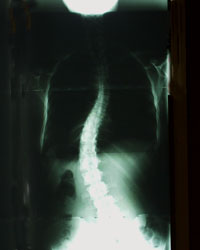
Front to back X-ray of adolescent idiopathic scoliosis
Question: Can AIS be treated without surgery?
Dr. Frey
Some cases of AIS can be treated non-surgically and others require surgical intervention.
Small curves, those less than 15-20 degrees are observed for possible progression over a period of time. At this stage, no specific treatment is needed. Larger curves, those between 20-40 degrees will require bracing to prevent further progression of the curve.
Some adolescents find wearing the brace 16 to 23 hours every day difficult. Braces can be uncomfortable, unattractive, hot, and can make a child self-conscious even though well disguised under clothing. However, when bracing works and surgery is avoided, the commitment required is worthwhile. At this point a carefully designed exercise program may also be recommended.
Question: Does bracing always work to stop the scoliosis?
Dr. Frey
Not always. Some curves do not respond to bracing. Cervicothoracic (curves from the middle of the back up into the neck) and curves greater than 40 degrees tend not to respond well to bracing.
Question: What are the goals of spine surgery for AIS?
Dr. Frey
Surgery may be recommended for curves in excess of 40 degrees. Surgery for scoliosis involves special surgical implants such as rods, hooks, screws, and wires. The goal is to straighten and balance the spine and secure it in place (fusion) so curve progression stops while skeletal maturity is reached. Surgery does not cure scoliosis; it is simply a way to manage the progression of the disease to avoid greater deformity.
Spine surgeons utilize various surgical procedures to treat AIS. The overall goals are always the same, but the techniques and instrumentation used will vary from case to case. Your surgeon may perform the procedure from the front (anterior) or from the back (posterior). He may even make extensive use of minimally invasive techniques. Your spine surgeon is the best person to discuss these options, indications, and potential complications with you and your child.
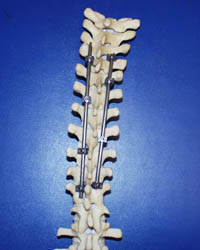
Bone model with implants to reduce curvature
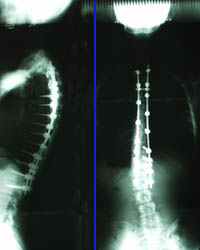
Post-operative X-ray showing implants reducing curvature
Thank you Dr. Frey for answering our questions. We appreciate your time and expertise.
Dr. Frey
You are welcome.



